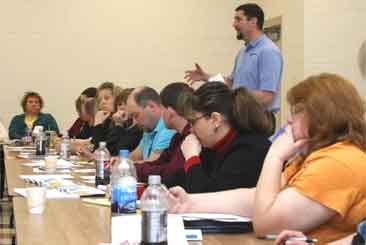|
|
| Reentry Effort Advances |
| By Bob Anez, Communications Director, Montana Department of Corrections |
| Published: 03/19/2012 |
 The Department of Corrections' project to enhance
and focus its reentry efforts was introduced
to key staff at Montana State Prison in early February,
a recognition of the critical role that the
state's largest correctional facility must play in the
success of the effort.
The Department of Corrections' project to enhance
and focus its reentry efforts was introduced
to key staff at Montana State Prison in early February,
a recognition of the critical role that the
state's largest correctional facility must play in the
success of the effort.
More than 40 unit managers and case managers from throughout the 1,485-bed Deer Lodge prison gathered for the briefing on the Montana Reentry Initiative. Deputy Warden Ross Swanson laid the groundwork for the more than three-hour meeting by emphasizing that providing reentry services and programs that help inmates transition to their communities upon leaving prison is nothing new. But the new effort to improve that work is here to stay, he said. "All of us in our job duties have been doing reentry over the years," he said. "What we haven't seen is an overall orchestrated effort in the Department of Corrections.” Changes in state and department leadership won't alter the initiative, he added. "Regardless of the new governor and new director, we will be doing reentry and we will be doing it better." Updating the prison staff was a key part of the reentry effort since the process of preparing inmates for reentering communities has to begin when offenders enter prison and continue through their release and their time under community supervision. Sam Casey, DOC's reentry coordinator, said prison is where an offender management plan has to be developed as a "roadmap" that follows each offender through his or her time in the corrections system. The key to that plan is consistent use of a valid, uniform tool for assessing every offender's needs and risks, he said. The result will be a clear indication of how to address the educational, addiction, employability, housing and social needs of inmates, Casey explained. The point at which inmates are handed off to community supervision must be seamless and effective if the benefits provided in prison are to transfer to parole or probation, he said. Prison staff must have the skills to show empathy, provide positive feedback and to intervene at critical times, Casey added. "You are agents for change. You have to remove barriers to change. Don't be one." Swanson noted that the prison is changing a policy to put more emphasis on education among inmates, who will soon be required to obtain a GED before they can have work assignments. In addition, the prison's education and vocational programs will merge to create more efficiency, he said. The unit and case managers offered a variety of advice and insights into challenges that reentry efforts face in prison. Among the comments:
Reprinted with permission. Other articles by Anez |
Comments:
Login to let us know what you think
MARKETPLACE search vendors | advanced search

IN CASE YOU MISSED IT
|


Patent litigation is a long expensive progress. That’s why it is important to get the best lawyer who can do a good job for you. The Waco Division of the Western District of Texas has emerged as a major player in patent litigation. There are a few lawyers who can take a case with bad facts and bad law and make it into something special. When you’re looking for that type of lawyer, it can be especially hard to find. Do you evaluate based on educational background? Number of accolades? Do you trust a referral from a friend? One lawyer may have done a good job for your friend, but that is because their situation was much different and the lawyer you need has a different focus. Do you look for a lawyer who is board certified in a particular field? If you are looking a lawyer that focuses on Waco Patent Litigation it is important to see what the people in Waco think of the lawyer’s services. Understanding the nuances of particular judges and local customs is critical in getting heard. There are few ways that it could pay off poorly to find the right lawyer for your case. That’s why it’s a safe bet to find the best people for your job.